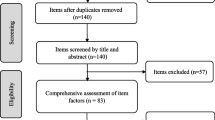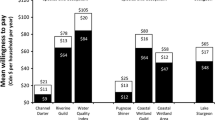Abstract
We conduct a meta-analysis (MA) of around 100 studies valuing species and nature conservation in Asia and Oceania, using both revealed and stated preferences methods. Dividing our dataset into two levels of heterogeneity in terms of good characteristics (species vs. nature conservation more generally) and valuation methods, we show that the degree of regularity and conformity with theory and empirical expectations is higher for the more homogenous dataset of contingent valuation of species. For example, we find that willingness to pay (WTP) for preservation of mammals tends to be higher than other species and that WTP for species preservation increases with income (elasticity below one). For the full dataset we find that marine habitats are valued significantly higher than other habitat types in the region. Despite some encouraging results, more research is required to answer the question of how homogenous is homogenous enough in MA, especially when moving towards using MA for benefit transfer and policy use.
Similar content being viewed by others
Notes
Originally quoted in Stanley and Jarrel (2005).
An alternative approach to dealing with classical MA challenges, not pursued here, is to use Bayesian techniques (e.g. Moeltner et al. (2007).
For simplicity and brevity we do not elaborate the details of how nature conservation may increase utility e.g. related to market goods and household production, e.g. as done by Van Houtven et al. (2007) for water quality.
The ecosystem services and functions and total economic value from nature and biodiversity conservation are discussed in depth elsewhere, and not elaborated in detail here (see e.g. Fromm 2000).
We did not include Master theses for practical reasons (hard to find and/or to get hold of) and because many are written in the native language.
Since the Australian database ENVALUE is no longer updated, has been (partly) integrated with EVRI and includes limited study information, our main search used the EVRI database.
We do not claim to have collected an exhaustive database of all studies in Asia and Oceania, but we are confident that we cover the majority of such studies in the region until 2009. Further, it is unlikely that our search has been biased in any way.
Studies that reported results with per unit of an area were excluded, as the total size typically was not given.
See the tables in the supplementary Appendix for classifications of the studies along some of these main dimensions.
Which also tend to be reflected in actual conservation policies (see e.g. Metrick and Weitzman 1996).
We also considered using population density of the country of study as a variable, for example as done by Brander et al. (2006) for wetlands. However, we think link between nature conservation and population density may be overly tenuous, and excluded this variable in our analysis.
A small number of studies survey foreign populations, e.g. Bandara and Tisdell (2005) study OECD citizens’ WTP for the preservation of the Giant Panda in China.
We also tested two other stratifications of the data: by survey and by author. Results (available from the authors) show that in many model specifications of the two stratifications equal effects (and random effects) cannot be rejected.
Standard error of WTP estimates was generally not reported, making it impossible to weigh estimates by level of precision in the meta-regressions, a procedure recommended in the MA literature (e.g. USE PA (2006)). Using the sample sizes as proxy would also loose to many observations.
A comprehensive test would have included other explanatory variables with different model specifications, but for sake of simplicity and brevity, we only present the model with the income variable here.
We also tried other groupings or specifications of types of species, such as size, degree of”charisma” across types of species etc., but found that using the biological classification”mammal” worked best in our models. Adding dummies for each species is not feasible due to the limited number of observations for each.
The variable mandatory is excluded here as it is collinear with the valuation method variables.
The TCM variable is the”hidden” category in Model 3, now that other non-SP methods are excluded. In Models 1-2 the TCM variable is excluded as it is not significant across models.
Since R 2 obtained from random-effects models is not directly comparable to standard R 2 OLS, the comparison should be interpreted with caution.
\( {\hbox{TE}}=\frac{{|{\hbox{WTP}}_{T}-{\hbox{WTP}}_{B} |}}{{{\hbox{WTP}}_{B}}} \), where T = transferred (predicted) value from study site(s), B = estimated (observed) true value (“benchmark”) at policy site.
References
Bandara R, Tisdell C (2005) Changing Abundance of Elephants and Willingness to Pay for their Conservation. J Environ Manag 76:47–59
Barrio M, Loureiro M (2010) A meta-analysis of contingent valuation forest studies. Ecol Econ 69:1023–1030
Bateman IJ, Jones AP (2003) Contrasting conventional with multi-level modeling approaches to meta-analysis: expectation consistency in UK woodland recreation values. Land Econ 79:235–258
Bateman IJ, Carson RT, Day B, Hanemann WM, Hanley N, Hett T, Jones-Lee M, Loomes G, Mourato S, Ozdemiroglu E, Pearce DW, Sugden R, Swanson T (2002) Economic valuation with stated preference techniques: a manual. Edward Elgar Publishing, Cheltenham
Bergstrom JC, Taylor LO (2006) Using meta-analysis for benefits transfer: theory and practice. Ecol Econ 60:351–360
Brander LM, Florax RJGM, Verrmaat JE (2006) The empirics of wetland valuation: a comprehensive summary and a meta-analysis of the literature. Environ Resour Econ 33:223–250
Brander LM, van Beukering P, Cesar H (2007) The recreational value of coral reefs: a meta-analysis. Ecol Econ 63:209–218
Carson RT, Flores NE, Martin KM, Wright JL (1996) Contingent valuation and revealed preference methodologies: comparing the estimates for quasi-public goods. Land Econ 72:80–99
Champ PA, Flores NE, Brown TC, Chivers J (2002) Contingent valuation and incentives. Land Econ 78:591–604
Desvousges WH, Johnson FR, Banzhaf HS (1998) Environmental policy analysis with limited information: principles and applications of the transfer method. Edward Elgar, Cheltenham
Engel S (2002) Benefit function transfer versus meta-analysis as policy-making tools: a comparison. In: Florax RJGM, Nijkamp P, Willis KG (eds) Comparative environmental economic assessment. Edward Elgar, Cheltenham, pp 133–153
Freeman AMI (2003) The measurement of environmental and resource values. Resource for the Future Press, Washington
Fromm O (2000) Ecological structure and functions of biodiversity as elements of its total economic value. Environ Resour Econ 16:303–328
Glass GV, McGaw B, Smith ML (1981) Meta-analysis in social research. Sage, Beverly Hills
Hoehn JP (2006) Methods to address selection effects in the meta regression and transfer of ecosystem values. Ecol Econ 60:389–398
Jacobsen JB, Hanley N (2009) Are there income effects on global willingness to pay for biodiversity conservation. Environ Resour Econ 43:137–160
Jacobsen JB, Boiesen JH, Thorsen BJ, Strange N (2008) What’s in a name? The use of quantitative measures versus ‘Iconised’ species when valuing biodiversity. Environ Resour Econ 39:247–263
Jianjun J, Zhishi W, Xuemin L (2008) Valuing black-faced spoonbill conservation in Macao: A policy and contingent valuation study. Ecol Econ 68:328–335
Johnston RJ, Besedin EY, Iovanna R, Miller CJ, Wardwell RF, Ranson MH (2005) Systematic variation in willingness to pay for aquatic resource improvements and implications for benefit transfer: a meta-analysis. Can J Agric Econ 53:221–248
Johnston RJ, Besedin EY, Ranson MH (2006) Characterizing the effects of valuation methodology in function-based benefits transfer. Ecol Econ 60:407–419
Kriström B, Riera P (1996) Is the income elasticity of environmental improvements less than one? Environ Resour Econ 7:45–55
Lindhjem H (2007) 20 years of stated preference valuation of non-timber benefits from Fennoscandian forests: a meta-analysis. J Forest Econ 12:251–277
Lindhjem H, Navrud S (2008) How reliable are meta-analyses for international benefit transfers? Ecol Econ 66:425–435
Lindhjem H, Navrud S (2009) Asking for individual or household willingness to pay for environmental goods: implication for aggregate welfare measures. Environmental and resource economics 43:11–29
Lindhjem H, Navrud S (2011a) Are Internet surveys an alternative to face-to-face interviews in contingent valuation? Ecol Econ 70:1628–1637
Lindhjem H, Navrud S (2011b) Using Internet in Stated Preference Surveys: a review and comparison of survey modes. Int Rev Environ Resour Econ (Forthcoming)
Metrick A, Weitzman ML (1996) Patterns of behavior in endangered species preservation. Land Econ 72:1–16
Millennium Ecosystem Assessment (2005) Synthesis report. Island Press, Washington
Moeltner K, Boyle K, Paterson RW (2007) Meta-analysis and benefit transfer for resource valuation—addressing classical challenges with Bayesian modeling. J Environ Econ Manag 53:250–269
Navrud S, Ready R (eds) (2007) Environmental value transfer: issues and methods. Springer
Nelson JP, Kennedy PE (2009) The use (and Abuse) of meta-analysis in environmental and natural resource economics: an assessment. Environ Resour Econ 42:345–377
Pearce D (2005) Economists and biodiversity conservation: what can we contribute?. EAERE, Bremen
Ready R, Navrud S (2006) International benefit transfer: methods and validity tests. Ecol Econ 60:429–434
Richardson L, Loomis J (2009) The total economic value of threatened, endangered and rare species: an updated meta-analysis. Ecol Econs 68:1535–1548
Rosenberger RS, Johnston RJ (2009) Selection effects in meta-analysis and benefit transfer: avoiding unintended consequences. Land Econ 85:410–428
Rosenberger R, Loomis J (2000a) Panel stratification in meta-analysis of economic studies: an investigation of its effects in the recreation valuation literature. J Agric Appl Econ 32:131–149
Rosenberger RS, Loomis JB (2000b) Using meta-analysis for benefit transfer: in-sample convergent validity tests of an outdoor recreation database. Water Resour Res 36:1097–1107
Schläpfer F (2006) Survey protocol and income effects in the contingent valuation of public goods: a meta-analysis. Ecol Econ 57:415–429
Shrestha RK, Loomis JB (2003) Meta-analytic benefit transfer of outdoor recreation economic values: testing out-of-sample convergent validity. Environ Resour Econ 25:79–100
Smith VK, Pattanayak SK (2002) Is meta-analysis a Noah’s Ark for non-market valuation? Environ Resour Econ 22:271–296
Stanley TD, Jarrel SD (2005) Meta-regression analysis: a quantitative method of literature surveys. J Econ Surveys 19:299–308
Stapler RW, Johnston RJ (2009) Meta-analysis, benefit transfer, and methodological covariates: implications for transfer error. Environ Resour Econ 42:227–246
Tuan TH, Lindhjem H (2009) Meta-analysis of nature conservation values in Asia and Oceania: data heterogeneity and benefit transfer issues. In: Lindhjem H (ed) Methodological issues in meta-analysis, benefit transfer and environmental valuation. PhD Thesis. Department of Economics and Resource Management, Norwegian University of Life Sciences, Norwegian
USEPA (2006) Report of the EPA work group on VSL meta-analysis, report NCEE-0494. National Center for Environmental Economics, EPA, Washington
Van Houtven G, Powers J, Pattanayak SK (2007) Valuing water quality improvements using meta-analysis: is the glass half-full or half-empty for national policy analysis? Resour Energy Econ 29:206–228
Wiser R (2007) Using contingent valuation to explore willingness to pay for renewable energy: a comparison of collective and voluntary payment vehicles. Ecol Econ 62:419–432
Zandersen M, Tol RSJ (2009) A meta-analysis of forest recreation values in Europe. J Forest Econ 15:109–130
Acknowledgments
We would like to thank Vic Adamowicz, Ståle Navrud and Randall Rosenberger for constructive comments. Funding from the Environment and Economy Programme for Southeast Asia (EEPSEA) is greatly appreciated.
Author information
Authors and Affiliations
Corresponding author
Electronic supplementary material
Below is the link to the electronic supplementary material.
About this article
Cite this article
Lindhjem, H., Tuan, T.H. Valuation of species and nature conservation in Asia and Oceania: a meta-analysis. Environ Econ Policy Stud 14, 1–22 (2012). https://doi.org/10.1007/s10018-011-0019-x
Received:
Accepted:
Published:
Issue Date:
DOI: https://doi.org/10.1007/s10018-011-0019-x




